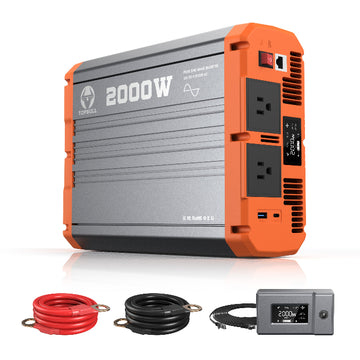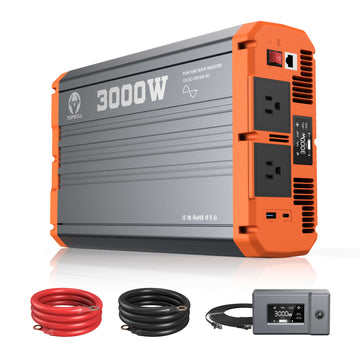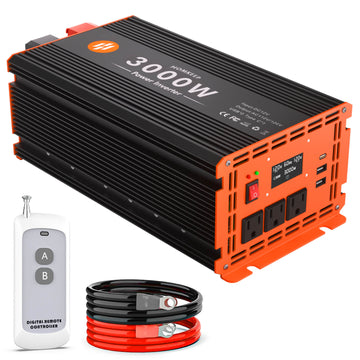RV travel has become increasingly popular as people's lifestyles change. It offers the comfort of having a home while enjoying nature. However, one of the biggest electrical pain points in RV life is facing the conflict between limited energy storage and high-power electrical devices. Especially in hot summers or cold winters, air conditioning becomes crucial to ensure RV comfort.
Why do RVs need inverters?
The inverter plays a crucial role in the RV electrical system. It is responsible for converting DC power (from batteries or solar panels) into AC power for air conditioning and other electrical devices. It is important to note that RV air conditioners have specific needs for inverters, such as power matching, stability of output, and compatibility of equipment, so choosing the right inverter is crucial.
Core Parameters of RV Air Conditioning Inverter Explained
1. Power and Capacity: How to Match Air Conditioning Demand?
Air Conditioner Power Calculation
To choose the right inverter, you first need to understand the power demand of the air conditioner. Take 1.5 HP air conditioner as an example, its rated power is about 1200W, and the peak current during startup may reach 2 to 3 times of the rated power. Therefore, the power of the inverter should be at least 2400W to 3600W to ensure the unit starts and operates properly.
Inverter Power Selection
Inverters are usually adapted to different voltage systems, such as 12V, 24V and 48V. Select an inverter with a power range of 1500W to 5000W and match it to the actual needs of your RV, e.g., using a 2000W inverter combined with a 300Ah Li-ion battery to drive a 1.5 HP air conditioner.
What size inverter do I need to run my RV A/C?
The power ratings of air conditioners for RVs usually vary depending on the type of air conditioner and its purpose. Below is a reference table of the power rating ranges and recommended inverters for several common RV air conditioners:
| Type of AC | Rated power (W) | Starting power (W) | Inverter power (W) |
| 1 HP split air conditioner | 750 | 1500 | 1500-2000 |
| 1.5 HP split air conditioner | 1200 | 2400 | 2500-3000 |
| 2 HP split air conditioner | 1800 | 3600 | 4000-5000 |
| Portable air conditioner | 1000 | 2000 | 2000-2500 |
| Vehicle air conditioner | 1200 | 2400 | 2500-3000 |
| Small solar air conditioner | 300-500 | 800 | 1000-1500 |
2. Waveform type: pure sine wave vs. modified sine wave
The waveform output from the inverter has a direct impact on the operating efficiency and lifespan of the air conditioning motor. Pure sine wave inverter can output the same waveform as utility power, which is more friendly to air-conditioner motor and can reduce noise and loss; while modified sine wave inverter is cheaper, but it may cause the air-conditioner to have difficulty in starting or the motor may be overheated due to waveform distortion. For RV air conditioning, a pure sine wave inverter is the better choice.
Learn more about the difference between pure sine wave inverters and modified sine wave inverters
3. Efficiency and Heat Dissipation: The Key to Long Life
The conversion efficiency of the inverter determines the utilization rate of electrical energy. High-efficiency inverters (e.g., 90% or more) can reduce energy loss and extend battery life. At the same time, heat dissipation design should not be neglected. Inverters generate a lot of heat when working, and poor heat dissipation may lead to performance degradation or even damage. Therefore, it is important to choose an inverter with fans, heat sinks and good casing materials.
Topbull inverters have a built-in high-efficiency cooling fan with a large heat sink, which can quickly export the internal heat and ensure stable performance even when the equipment is running under high load for a long period of time. In addition, its shell is made of high-strength, high-temperature-resistant materials, which not only improves the overall durability, but also further enhances the heat dissipation effect, providing more reliable power protection for RV traveling.
Selection Guide for RV Air Conditioning Inverter
1. Battery Compatibility
The inverter needs to be adapted to different types of battery systems, such as lead-acid batteries vs. lithium batteries, and the compatibility with solar energy systems (e.g., MPPT controllers) needs to be considered. Make sure the input voltage of the inverter is compatible with the selected battery system, such as 12V, 24V or 48V.
2. Safety and Protection
For safety, it is important to choose an inverter with overload protection, short-circuit protection and overheat protection. In addition, the low voltage alarm and automatic shutdown function can effectively prevent the battery from over-discharging and prolong the service life of the battery.
3. Installation and Portability
According to the space and usage requirements of RV, you can choose wall-mounted or portable inverters. Wall-mounted inverters are suitable for long-term use because of their fixed installation, while portable inverters are easy to carry and move around, which is suitable for temporary use of electricity. In addition, the type of interface also needs to be considered, such as AC output socket, USB charging port, remote control interface, etc., to meet the charging needs of different devices.
4.Best RV AC Inverter Recommendations
Topbull 2000W, 3000W and 4000W pure sine wave inverters are highly recognized in the market for their excellent power conversion efficiency and stable output waveform. They can efficiently convert DC power into high-quality AC power, ensuring stable and safe support for the operation of various high-power appliances, which is especially suitable for RV air conditioning. These inverters adopt advanced heat dissipation design with overload protection, short circuit protection and overheating protection, which greatly guarantees the safety and long service life of the equipment. In addition, the lightweight design makes them easy to carry and install, making them essential electrical equipment for RV life.
| Product Model | Topbull 2000W | Topbull 3000W | Topbull 4000W |
| Product Pictures |
 |
 |
 |
| Rated power | 2000W | 3000W | 4000W |
| Peak power | 4000W | 6000W | 8000W |
| Output Waveforms | pure sine wave | pure sine wave | pure sine wave |
| vantage | Suitable for general household appliances, fast startup, stable output | Provides higher power support to drive a wide range of devices | Ability to support high power devices such as air conditioners and large appliances |
| Suitable for AC | 1 HP, 1.5 HP air conditioners | 1.5 HP, 2 HP air conditioners | 2 HP and above air conditioners |
| Prices | $179.99 | $269.99 | $329.99 |
Installation and Use Tips for RV Air Conditioning Inverter
1. Pre-installation Preparation
Before installing the inverter, you need to plan the RV circuit. Determine the battery compartment location, inverter installation space and cable layout. Prepare the necessary tools and materials, such as wires, fuses, terminals, etc. 2.
2. Installation Steps
The inverter should be installed according to the principle of “correctly connecting positive and negative poles and reliable grounding wire”. First, fix the inverter in the intended position; then, connect the battery positive and negative terminals, grounding wire and air conditioner power cable according to the circuit diagram. Make sure that the cable specification matches the current to avoid wire damage and heat generation.
3. Tips for use
Before starting the air conditioner, you can warm up the inverter first to reduce the start-up shock. At the same time, reasonably distribute the load to avoid multiple devices running at high power at the same time. For example, when the air conditioner is running, turn off unnecessary electrical devices to reduce the burden on the inverter.
4. Maintenance and Troubleshooting
Clean the inverter heat sink and check the aging of cables regularly. If there are problems such as inverter alarm, abnormal output, etc., you can check the battery level, load condition and cable connection first. If the problem is still not solved, it is recommended to contact professional maintenance personnel for overhaul.
Optimization of RV Air Conditioning Inverter
1. Battery System Upgrade
For RV's power needs, choosing lithium batteries is more advantageous than lead-acid batteries, including lighter weight and longer service life. When purchasing, the battery capacity should be accurately calculated based on the air conditioning operating hours and inverter efficiency.
Learn more about Topbull 200Ah deep-cycle lithium batteries, ideal for RVs
2. Solar system supplementation
Solar panels combined with MPPT controllers can effectively extend the use of air conditioners. For example, a 400W solar panel combined with a 400Ah Li-ion battery and a 3000W inverter can ensure a longer power supply, thus increasing the self-sufficiency of the RV.
3. Emergency Power Solution
introduces a portable generator linked with an inverter for use as an emergency supplement when power is insufficient, ensuring the smooth operation of the RV in various environments.
Conclusion
RVs offer a free and flexible lifestyle, and inverters are the key component that makes this freedom possible. When selecting and using an inverter, it is important to consider power requirements, space constraints and equipment compatibility to find a power solution that suits your needs. Through continuous technological advancement and system optimization, it is believed that RV life will be more comfortable and convenient in the future.
FAQs About RV Air Conditioning Inverters
Q: Can an inverter drive both the air conditioner and other equipment at the same time?
A: Yes, the inverter can drive air conditioners and other devices at the same time, but only if the total power output of the inverter is higher than the sum of the power of all the devices. In addition, it should be ensured that the starting power of the air conditioner does not exceed the rated power of the inverter.
Q: Do I need a separate inverter for my RV air conditioner?
A: This depends on the RV's electrical system and the power requirements of the air conditioner. If the power of the air conditioner exceeds the capacity of the existing inverter, or to avoid burdening the system, it is best to use a separate inverter.
Q: Will a 2000-watt inverter run a RV air conditioner?
A: A 2000-watt inverter may be able to run a small RV air conditioner, typically those with a rated power under 2000 watts. However, you need to account for the starting wattage, which can be significantly higher than the running wattage. It's best to check the specifications of your specific A/C and air conditioner. check the specifications of your specific A/C unit.
Q: What should I do if the inverter alarms when the air conditioner is running?
A: If the inverter alarms while the air conditioner is running, first check to see if the load on the inverter exceeds its rated power. This may indicate a device overload or short circuit. You can try to turn off other devices or restart the inverter if the air conditioner is not working.
Q: Can I drive my RV with the inverter driving the air conditioner while driving?
A: Theoretically, you can use the inverter to drive the air conditioner while the RV is in motion, but you need to pay attention to the battery level of the vehicle. However, you need to pay attention to the battery level of the vehicle. If the battery is not sufficiently charged, prolonged use of the air-conditioner may cause the battery to run down.
Q: Is a portable inverter suitable for powering the air-conditioner?
A: Whether a portable inverter is suitable for powering an air conditioner depends on its power rating. Most portable inverters have a low power rating, which is usually not enough to support the start-up and continuous operation of an air conditioner. Choose Topbull's high power portable inverters to meet your air conditioner's operational needs!













